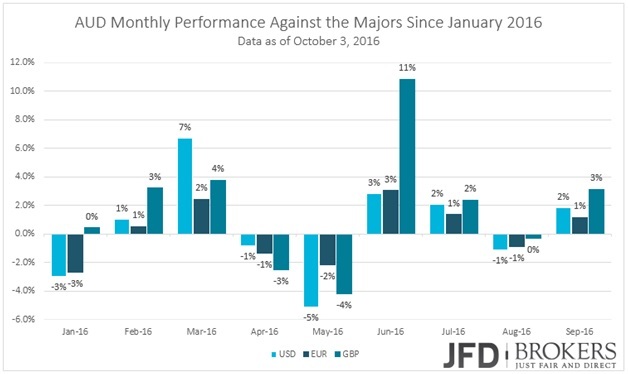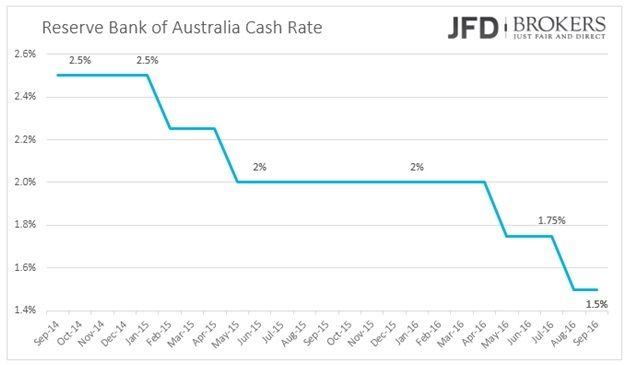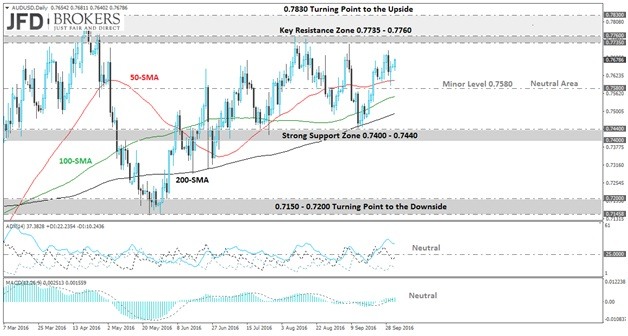The Australian dollar, relative to the three big currencies (USD, EUR and GBP), have continued to recover. After a long secular decline over previous years, the Australian dollar managed to recover some ground and over the last four months it recorded more than 7% versus the U.S. dollar, the euro, and the pound showing some positive signs that it could sustain those gains. Despite the low-environment of volatility – we haven’t seen the AUD record more than 4% of gains in a month versus the euro and U.S. dollar – we expect the next few months to be more volatile as the Federal Reserve is expected to increase its rates at its last meeting while the Reserve Bank of Australia (RBA) is expected to lower its cash rate in the near term.
|
|
Short-Term |
Medium-Term |
General Outlook |
|
Technical View |
Neutral |
Bearish |
Bearish |
|
Fundamental View |
Neutral |
Neutral-Bearish |
Fundamental Analysis
The RBA has already had two rate cuts this year, in May and August, at a record low of 1.50%, to boost the country’s inflation and confront as painlessly as possible the decline of the mining sector. Since the last quarter of 2014, inflation stacked below the central bank’s 2% - 3% inflation target range and the easing policy barely helped the growth of consuming prices from a further slowdown. An additional reason for the RBA’s easing policy is the depreciation of its domestic currency in order to boost export of Australian goods and services. Australian economic growth is strong enough, at 3.3% according to the last available data, however the RBA ex-Governor Glenn Stevens was trying to keep many parameters intact to retain a sustainable growth (like trading and the mining sector), and then drive the market to the central bank’s inflation target range.
No changes are expected in the policy meeting tonight, and we expect the economy to adopt a ‘hold-and-see’ stance for a while. However, as the central bank wants a lower domestic currency in order to boost exports and inflation rate falls even further, more easing in the next half year is very likely.
It’s worth to mention that Glenn Stevens retired in September after a decade as Head of the Reserve Bank of Australia, and he is replaced by Philip Lowe. In our opinion, we should also adopt a wait-and-see stance for the next policy meeting to find out whether Dr. Lowe will have a dovish or hawkish handle on the economy. Thus, this month we should pay further attention to the RBA rate statement to gauge the new governor’s policy.
AUD/USD - Technical Analysis
The AUD/USD pair remains without trend direction and above the 0.7500 level, but with a modest positive tone according to the daily chart, as the price holds above its moving averages (50-SMA, 100-SMA, and 200-SMA), which anyway remain flat and all together in a tight range between the 0.7400 – 0.7760 zone. Still, the pair lacks directional momentum and the significant resistance zone at 0.7735 – 0.7760 keeps capping the upside, while a year-high stands at 0.7830 - the level to surpass to confirm a bullish trend direction.
Therefore, the 0.7735 – 0.7760 zone and the 0.7830 level will be key to watch for over the next few sessions. On the other hand, below 0.7580 (a minor level), the pair can test the 0.7400 – 0.7440 price zone, although it seems unlikely that the U.S. dollar will find enough demand if the Reserve Bank of Australia decides to leave its cash rate unchanged for the second time in a row.
Conclusion
From our point of view, the Australian dollar is vulnerable to deeper losses against the three big currencies (USD, EUR, and GBP) for the remainder of the year. The Australian economy is performing reasonably well given current circumstances, but a sustained pickup in growth is not anticipated for some time. Moreover, a number of downside risks for the Australian economy have not eased. We are assured that the drop in commodity prices has not hit bottom yet, while China’s slowdown, which weighs on global growth, particularly in commodity dependent countries such as Australia and Canada, has not ended. Moreover, the Federal Reserve is expected to raise interest rates in the remainder of this year, most likely in its December meeting, which would provide support to the U.S. dollar and weigh negative on the Australia dollar.
The content we produce does not constitute investment advice or investment recommendation (should not be considered as such) and does not in any way constitute an invitation to acquire any financial instrument or product. JFD Group, its affiliates, agents, directors, officers or employees are not liable for any damages that may be caused by individual comments or statements by JFD Group analysts and assumes no liability with respect to the completeness and correctness of the content presented. The investor is solely responsible for the risk of his investment decisions. Accordingly, you should seek, if you consider appropriate, relevant independent professional advice on the investment considered. The analyses and comments presented do not include any consideration of your personal investment objectives, financial circumstances or needs. The content has not been prepared in accordance with the legal requirements for financial analyses and must therefore be viewed by the reader as marketing information. JFD Group prohibits the duplication or publication without explicit approval.
72,99% of the retail investor accounts lose money when trading CFDs with this provider. You should consider whether you can afford to take the high risk of losing your money. Please read the full Risk Disclosure: https://www.jfdbank.com/en/legal/risk-disclosure
Recommended Content
Editors’ Picks
EUR/USD edges lower toward 1.0700 post-US PCE

EUR/USD stays under modest bearish pressure but manages to hold above 1.0700 in the American session on Friday. The US Dollar (USD) gathers strength against its rivals after the stronger-than-forecast PCE inflation data, not allowing the pair to gain traction.
GBP/USD retreats to 1.2500 on renewed USD strength

GBP/USD lost its traction and turned negative on the day near 1.2500. Following the stronger-than-expected PCE inflation readings from the US, the USD stays resilient and makes it difficult for the pair to gather recovery momentum.
Gold struggles to hold above $2,350 following US inflation

Gold turned south and declined toward $2,340, erasing a large portion of its daily gains, as the USD benefited from PCE inflation data. The benchmark 10-year US yield, however, stays in negative territory and helps XAU/USD limit its losses.
Bitcoin Weekly Forecast: BTC’s next breakout could propel it to $80,000 Premium

Bitcoin’s recent price consolidation could be nearing its end as technical indicators and on-chain metrics suggest a potential upward breakout. However, this move would not be straightforward and could punish impatient investors.
Week ahead – Hawkish risk as Fed and NFP on tap, Eurozone data eyed too

Fed meets on Wednesday as US inflation stays elevated. Will Friday’s jobs report bring relief or more angst for the markets? Eurozone flash GDP and CPI numbers in focus for the Euro.



